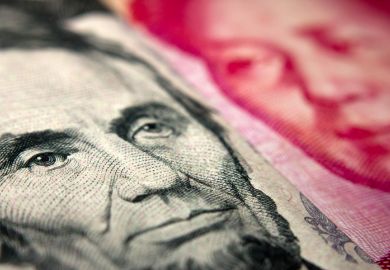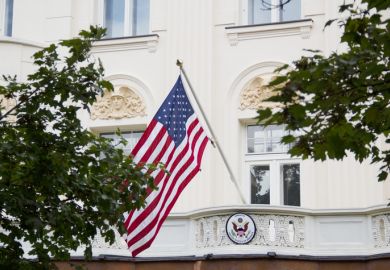The director of the US National Institutes of Health has denied any xenophobic intent in its crackdown on academic scientists with ties to China, but acknowledged that the organisation may not be looking closely enough at all of its grant recipients.
The possibility that many researchers without Chinese ties are behaving similarly to those pointed out to their institutions by the NIH, and then fired or forced out, “certainly is a good point” worth checking, Francis Collins told Times Higher Education.
At least a half-dozen scientists at three leading US universities have now been ousted, without clear explanations of their exact offences, raising concerns that the NIH and its science mission is being sidetracked by a wider government confrontation with China.
The top NIH official in charge of awarding grant money to universities, Michael Lauer, said that the agency was simply responding in an unbiased manner to outside allegations and internal evidence of financial and scientific fraud.
That has led so far to advisory letters from the NIH to some 65 academic institutions, and 19 ongoing government investigations, said Dr Lauer, the NIH’s deputy director for extramural research.
The attention on China, he said, reflected a reality that problems identified by the NIH and FBI – mostly a failure by grant recipients to fully disclose other relevant funding and ties, and the improper sharing of grant-related information with outsiders – happened to be occurring overwhelmingly in the context of China.
The rate of such violations by NIH-funded researchers outside the context of China was “vanishingly small”, Dr Lauer said. In the case of improper funding disclosures, “we might see one or two pairs every six months”, he said, “whereas this is on a completely different scale, what we’re seeing from the Chinese Thousand Talents programme”, a decade-old Chinese government effort to boost its national standing in sciences.
The NIH’s concern was not espionage or national security, Dr Lauer said, but protecting the agency from wasted spending and universities from intellectual property theft. “Our primary function is to fund outstanding science and then to function as effective stewards,” he said.
Yet such pecuniary explanations for hunting or finding scientists with Chinese ties don’t appear to match the reality of how the NIH has long treated its grant recipients, several experts said.
While the NIH does require scientists to disclose funding for work related to the topic of a grant application, the agency has in practice understood that there is wide room for interpretation, said one former top NIH official, Jeremy Berg.
One major class of examples, said Dr Berg, a former director of the NIH’s National Institute of General Medical Sciences, involved the private Howard Hughes Medical Institute, which supplies scientists with largely unrestricted pools of money.
Dr Berg, now associate senior vice-chancellor in health sciences at the University of Pittsburgh, said that he recalled Hughes-funded researchers regularly seeking NIH grants and denying any overlap with their Hughes work.
“And that was sort of tautologically true, because the funding from Howard Hughes wasn’t associated with any particular project,” he said. “But I didn’t believe for a second that there weren’t dollars that were being commingled to help the NIH projects benefit from the Hughes funding.”
The NIH generally made clear, said Ferric Fang, a professor of laboratory medicine and microbiology at the University of Washington, that concurrent funding on the same topic must be disclosed in grant applications. The NIH was far less clear, Professor Fang said, on disclosures of data already obtained from previous funding, which essentially would allow the diversion of new NIH grant income to non-declared purposes.
The crackdown on scientists for sharing internal grant review information with their colleagues in China also appears to be a matter of highly selective enforcement, the experts said.
Most scientists chosen to help the NIH evaluate grant applications took seriously the need for confidentiality, Dr Berg said. Yet violations happen. Dr Berg recalled multiple instances where, “Twenty-four hours after the study section has met, all the leaders in the field knew exactly what score everybody got” on their grant applications.
Any punishment, however, rarely goes beyond a reprimand or, if necessary, disqualification for future grant review work, Dr Berg said. “It’s actively discouraged, but it certainly hasn’t been criminalised,” he said.
Dr Lauer, however, said the NIH was currently looking into 80 cases of peer review confidentiality violations that went beyond any concerns of foreign influence. While the NIH cannot discuss specific cases, responses to such actions have “gone way beyond reprimands”, he said.
Still, Dr Collins acknowledged that his agency might not be paying as much attention to issues of funding disclosure and sharing of grant review data when it lacked an overseas component.
“Maybe this is the moment to look,” Dr Collins said. “We have to be even-handed – we have to have the same standards for everybody.”
POSTSCRIPT:
Print headline: ‘We need the same standards for everyone’
Register to continue
Why register?
- Registration is free and only takes a moment
- Once registered, you can read 3 articles a month
- Sign up for our newsletter
Subscribe
Or subscribe for unlimited access to:
- Unlimited access to news, views, insights & reviews
- Digital editions
- Digital access to THE’s university and college rankings analysis
Already registered or a current subscriber?








